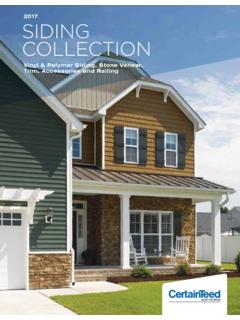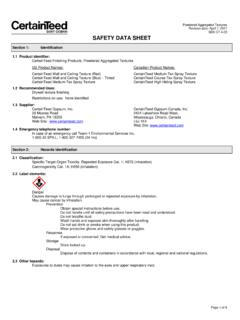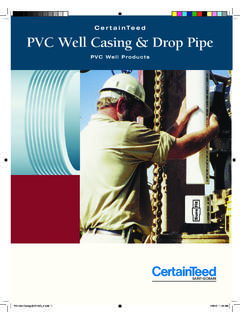Transcription of CertainTeed Shingle Applicator’s Manual Shingle …
1 38 YOUR OBJECTIVE: To learn the differences between the various underlayments available. To learn when a particular type of underlayment is the best choice for a particular situation, and to learn how to correctly install the different types of are two major types of Shingle underlayment: water-resistant and waterproof. Within these types are many variations both between brands and within brands. sUNDERLAYMENT SPECIFICATIONStWATER RESISTANT UNDERLAYMENTTwo common grades of water resistant Shingle underlayment are available; #15, also known as standard Shingle underlayment, and #30, also known as heavy duty Shingle underlayment. However, within those grades there are many choices. For example, among standard Shingle underlayment (#15), the following can be found:u UNRATED Shingle UNDERLAYMENT.
2 Generally the lowest priced and having the most unpredictable levels of asphalt saturation. Quality may vary from batch to ASTM D 4869 (TYPE 1). All ASTM rated materials should be superior to unrated underlayment. However, an ASTM rating is not enforced by any independent organization. This rating is the standard specification for asphalt saturated organic felt Shingle underlayment used in roofing. It covers standard #15 Shingle underlayment, also known as Type 15 or Type 1. Because of a higher saturation level this product should not be subject to serious ASTM D6757 Shingle UNDERLAYMENT. This underlayment is an organic felt reinforced with fiber glass fibers and saturated with asphalt. Generally, they demonstrate a higher resistance to tearing than does any other #15 type underlayment and are very resistant to wrinkling.
3 They typically carry a UL classification, meets the ASTM D6757 standards and all performance requirements of ASTM D4869 and ASTM is also a wide selection among heavy duty underlayment products:u UNRATED HEAVY DUTY Shingle UNDERLAYMENT (#30). These heavy duty products are built using a heavier weight of organic felt; however, as mentioned above, unrated products are subject to wide variation in saturation. Under-saturated under-layments are subject to severe wrinkling. Under-saturated #30 underlayment has been known to wrinkle even after shingles are installed, telegraphing the wrinkles through the installed shingles after the job is finished. u ASTM D4869 (TYPE II). A more predictable quality of heavy duty underlayment, much more resistant to ASTM D226 (NONPERFORATED).
4 This is a heavier felt normally used in built-up roofing systems. These felts have a greater asphalt content and exhibit superior strength and resistance to wrinkling. u SYNTHETIC UNDERLAYMENT. There are a variety of these underlayments made from different synthetic components. All are light-weight and claim superior resistance to tearing and wrinkling. Most of these type underlayments carry one or more performance or approval ratings. ( meets one or more of the ASTM performance standards above, or has one or more industry recognized code-body approval). CertainTeed DiamondDeck is a synthetic, scrim-reinforced, water-resistant underlayment that can be used beneath Shingle , shake, metal or slate roofing. CertainTeed RoofRunner is a lightweight synthetic polymer-based water-resistant underlayment for use beneath asphalt have exceptional dimensional stability compared to standard felt underlayment.
5 And special top surface treatment that provides excellent slip resistance, even when Shingle UNDERLAYMENT Waterproofing Shingle Underlayment (WSU) is a very different kind of material. It is used in vulnerable locations on the roof deck that are most likely to leak during storms with high winds or when ice dams develop. Along the eaves, around roof penetrations and in the valleys are the areas most likely to require waterproof UNDERLAYMENTS ARE REQUIREDThe installation of water-resistant underlayment beneath shingles is required by many Shingle manufacturers. Generally, CertainTeed recommends that underlayment be installed but does not require it except as noted below. LOW SLOPE: All roof shingles applied to a low slope deck (2" to below 4" per foot) require the use of CertainTeed WinterGuard Waterproofing Shingle Underlayment, or its equivalent,* applied over the entire deck surface.
6 Consult the WinterGuard and individual Shingle application instructions for details. * For low slopes, underlayment equivalents to WinterGuard include: 1) waterproofing Shingle underlayments meeting ASTM D1970; 2) in areas not prone to snow or ice, two layers of CertainTeed DiamondDeck or RoofRunner in Shingle fashion (half lap) per the low-slope application instructions. 3) in areas not prone to snow or ice, two layers of 36" (915 mm) wide felt Shingle underlayment lapped 19 (485 mm). CertainTeed Shingle applicator s ManualShingle Underlayments5 39 CertainTeed Shingle applicator S Manual Chapter 5 Shingle underlayment should meet ASTM D6757, ASTM D4869 Type I or ASTM D226 Type I (except when applying LandMark TL or presidential TL Shake shingles).
7 Because water drains slowly from these slopes, there is a greater chance of water back-up and damage from ice-dams. The applica-tion instructions for each CertainTeed roofing product indicate the minimum slope below which the product must not be applied, and a range of slopes where low slope application instructions must be followed. These instructions call for the use of a waterproofing shin-gle underlayment, such as CertainTeed WinterGuard Waterproofing Shingle Underlayment, or it s equivalent. However, careful consideration of local weather and the use of a waterproof underlayment meeting ASTM D 1970 are thought to be a good practice and recommended by CertainTeed . Follow the application instructions for the particular Shingle .
8 Note the special low slope application requirements for the products below:u LANDMARK TL AND presidential TL SHINGLES: Low slope application requires a layer of WinterGuard or an equivalent product over the entire roof deck. A double layer of asphalt felt underlayment is not an acceptable alternative when applying these WEATHER CLIMATES (ALL SLOPES): Application of WinterGuard or a waterproofing Shingle underlayment meeting ASTM D1970 is strongly recommended whenever there is a possibility of ice build-up. Follow manufacturer s application instructions. VALLEY FLASHING: Line valley by centering 36" (915 mm) wide CertainTeed WinterGuard, or equivalent,** in the valley and applying directly to deck. Consult the WinterGuard and individual Shingle application instructions for details.
9 ** For valley liner, the equivalents to WinterGuard include: 1) waterproofing Shingle underlayments meeting ASTM D1970; 2) one layer of 50 lb. or heavier asphalt coated roll roofing; 3) one layer of mineral-surfaced roll roofing; 4) two layers of 36" (915 mm) wide felt Shingle underlayment. 5) in areas not prone to snow or ice, a synthetic water-resistant underlay-ment lapped at 20" and extending through the valley by at least 36". (Coated roll roofing should meet ASTM D224; Shingle underlayment should meet ASTM D6757, ASTM D4869 or ASTM D226.)REQUIREMENTS BY UNDERWRITERS LABORATORIES (UL) FOR FIRE-RATED PREPARED ROOFINGu UL classified underlayment is required under Class A fire-resistant shingles when plywood or non-veneer (OSB, WB, etc.
10 APA sheathing is at least 3/8" thick but less than 15/32". u When sheathing thicker than 15/32" is used under fiber glass-type shingles, Shingle underlayment is not required for a UL Class A fire rating. sWATER-RESISTANT UNDERLAYMENTStWater resistant underlayment is a product that consists of organic felt impregnated with asphalt saturant. Some water-resistant underlayments also contain a fiber glass reinforcement which increases tear strength and reduces wrinkling. There are a variety of these underlayments made from different synthetic components. All are light-weight and claim superior resis-tance to tearing and underlayment was originally invented to keep the roof decking dry until shingles could be applied. Applying this underlayment was originally called drying-in the roof.









